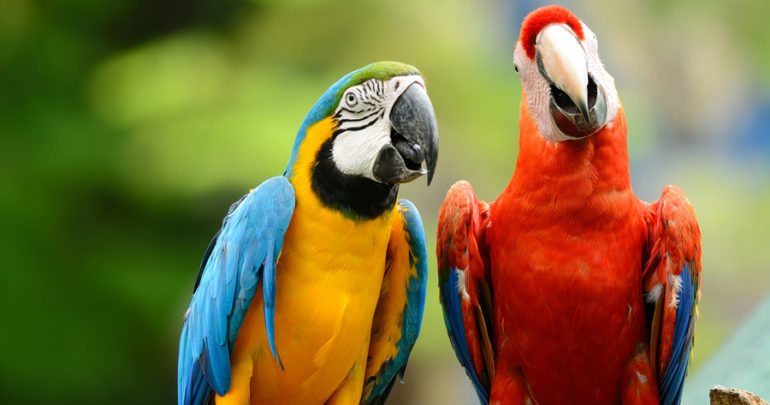There are more than 8.7 million species found on our planet and each species has its own life span i.e. the average duration for which a particular species lives. This lifespan differs for each species. Animals living under natural conditions rarely approach their maximum possible age because of very high death rates due to infant mortality, diseases, predators, bad weather, habitat destruction, or competition for food and shelter. On basis of every species lifespan living on this planet below is the list of top 10 animals which has the longest lifespan.
10. Macaws

Macaws are long tailed, often colourful parrots. There are total of 19 species of macaws found on the earth including extinct and critically endangered species. With this, there are several hypothetical extinct species that have been proposed based on a least evidence. The majority of macaws are wild and very few are extinct. The spix’s macaw is now probably extinct in the wild. The largest macaw species range from about 20 inches and upto 42 inches including their tail size. Now coming to their lifespan, they can live up to 60 to 80 years, while there breeding age ranges from 30 to 35 years. Mini macaws have lifespan at the lower end, while a large in size with good nutrition can easily live for a age more than 50 years.
9. African elephants

African elephants be elephants of the sort Loxodonta. The variety comprises of two surviving species: the African hedge elephant, L. Africana, and the littler African backwoods elephant, L. cyclotis. Loxodonta is one of two existing genera of the family. One types of African elephant, the hedge elephant, is the biggest living earthbound creature, while the woods elephant is the third-biggest. Their chunky bodies lay on stocky legs, and they have sunken backs. Their huge ears empower warm loss. The upper lip and nose shape a trunk. The largest surviving land-animals have an average lifespan of 70 years and a recent Zimbabwean study has found that female African elephants can potentially remain fertile until their death!
8. Galapagos Giant Tortoise

Satisfying its name, the Galapagos Giant Tortoise is the greatest tortoise on the planet. They’re likewise one of the laziest, dozing for almost 16 hours per day! Goliath Tortoises used to occupy each landmass aside from Antarctica. Goliath Galapagos Tortoises are not all the same, with relatively every island of the Galapagos having its own particular subspecies.
The temperature that the eggs are brooded in decides if they will gestate into males or females. A higher temperature implies that more males will be born. Their ease back digestion and capacity to go up against substantial volumes of water encourages them make due for up to a year without eating or drinking.
The biggest living types of tortoise that can survive well past a hundred, with the most established recorded at 152. The most well known Galapagos Tortoise was ‘Bereft George’, a sub species who lived on the Islands, he was 100 years of age and still classed as a youthful grown-up! He had turned into a minister of sorts for the islands off the shore of Ecuador.
7. Eels

An eel is any fish having a place with the request Anguilliformes, which comprises of four suborders, 20 families, 111 genera and around 800 species. Most eels are predators. The expression “eel” is additionally utilized for some other comparably formed fish, for example, electric eels and sharp eels, however these are not individuals from the Anguilliformes arrange.Eels are extended fish, running long from 5 cm in the one-jawed eel to 4 m in the thin monster moray.
Adults run in weight from 30 g to well more than 25 kg. They have no pelvic balances, and numerous species additionally need pectoral blades. The dorsal and butt-centric blades are combined with the caudal balance, framing a solitary lace running along a significant part of the length of the creature.
Eels have a avearge lifespan of 150 years. Do you know eels lay about more than 4 millions eggs in their whole life.
6. Tuataras

Tuatara are reptiles inhabitat to New Zealand. In spite of the fact that taking after most reptiles, they are a piece of a particular heredity. Their name gets from the Māori dialect, and signifies “crests on the back”.[3] The single types of tuatara is the main surviving individual from its request, which prospered around 200 million years ago.
Tuatara are greenish dark colored and dim, and measure up to 80 cm from make a beeline for tail-tip and weigh up to 1.3 kg with a spiked peak along the back, particularly articulated in guys. Their dentition, in which two lines of teeth in the upper jaw cover one column on the lower jaw, is one of a kind among living animal varieties. Tuatara most likely have the slowest development rates of any reptile, proceeding to become bigger for the initial 35 years of their lives. The normal life expectancy is around 150 years, yet they can live to be well more than 200 years of age.
5. Koi

Koi is a casual gathering of the shaded variations of the Amur carp. A few assortments are perceived by the Japanese. Koi assortments are recognized by shading, designing, and scalation. A portion of the significant hues are white, dark, red, yellow, blue, and cream. Carp are a huge gathering of fish initially found in Central Europe and Asia. Different carp species were initially trained in East Asia, where they were utilized as nourishment angle.
Carp are coldwater angle, and their capacity to survive and adjust to numerous atmospheres and water conditions enabled the tamed species to be proliferated to numerous new areas, including Japan. The Koi fish has a life span of over 200 years. This Japanese species of fish is a domesticated common carp that is kept for decorative purposes in outdoor koi ponds or water gardens.
4. Bowhead Whale

A stocky dim shaded whale without a dorsal blade, it can grow 14 to 18 m long. This thick-bodied species can weigh from 75 to 100 tons.They live altogether in prolific Arctic and sub-Arctic waters, not at all like different whales that relocate to low scope waters to encourage or recreate. The bowhead was otherwise called the Greenland right whale or Arctic whale. American whalemen called them the steeple-top, polar whale, or Russia or Russian whale. The bowhead has the biggest mouth of any creature.
Bowhead Whale has a average Life Span Over 200 Years. One hundred might be old for people and tortoises however it’s nothing for the bowhead whale. Truth be told, he’s just moderately aged by then in his astoundingly long life. This types of whale can live for more than 200 years.
3. Greenland shark

The Greenland shark, otherwise called the gurry shark, or dim shark is a vast shark of the family Somniosidae, firmly identified with the Pacific and southern sleeper sharks. The dispersion of this species is generally confined to the waters of the North Atlantic Ocean and Arctic Ocean. It has the longest known life expectancy of every single vertebrate specie which is not less than 274 years and is among the biggest surviving types of shark. As an adjustment to living at depth, it has a high convergence of trimethylamine N-oxide in its tissues, which makes the meat be toxic. Greenland shark substance treated to diminish poison levels is eaten in Iceland.
2. Arctica islandica

The sea quahog (Arctica islandica) is a types of consumable shellfish, a marine bivalve mollusk in the family Arcticidae. This species is local toward the North Atlantic Ocean, and it is reaped economically as a nourishment source. This species is additionally known by various diverse basic names, including Icelandic cyprine, mahogany mollusk, mahogany quahog, dark quahog, and dark clam.
The average Arctica islandica takes after the quahog, however the shell of the sea quahog is rounder, the periostracum is normally dark, and on the inside of the shell, the pallial line has no space or any sinus. Not at all like the quahog, which lives intertidally and can be gathered by mollusk burrowing, this species lives subtidally, and must be gathered by digging. They develop to sizes surpassing 50 mm shell height. An individual example was accounted for to have lived 507 years, making it the longest-lived non-provincial metazoan whose age was precisely known.
1. The immortal jellyfish

Turritopsis dohrnii, the immortal jellyfish, is a types of little, organically godlike jellyfish found in the Mediterranean Sea and in the waters of Japan. It is one of only a few known instances of creatures which can revert back to its premature state when exposed to stress or injury. One of very unique fish fit for returning totally to a sexually youthful, frontier arrange in the wake of having achieved sexual development as a singular person. Others incorporate the jellyfish Laodicea undulata and Aurelia sp.1.
The immortal jellyfish is most likely the longest living animal since it can possibly live for eternity. Agreeing a current report the eternal jellyfish changes itself from a grown-up over into a child through a procedure known as “transdifferentiation”, in which one type of cell changes into another. The jellyfish can repeat this procedure again and again into vastness. Whenever starvation, physical harm, or different emergencies emerge, rather than unavoidable passing, the immortal jellyfish changes the greater part of its current cells into a more youthful state.






